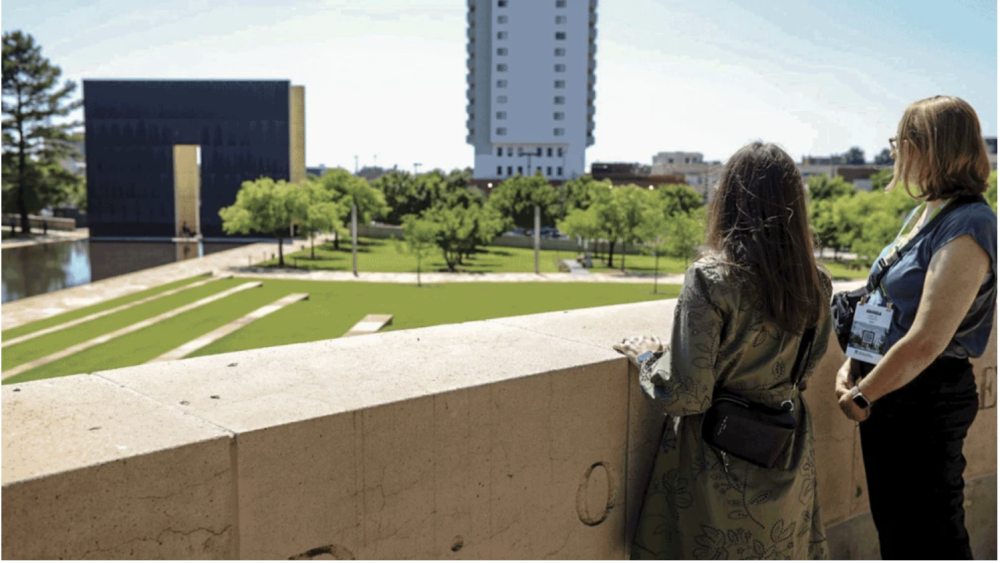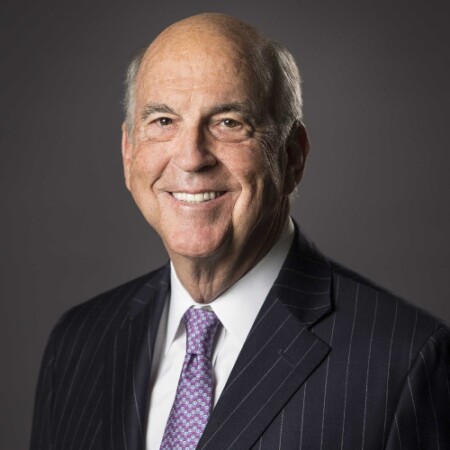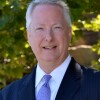Commemorating the 30th anniversary of the tragic bombing in downtown Oklahoma City finds the city itself experiencing nothing short of an amazing urban renaissance, after having pivoted from a suburban focus to a vibrant celebration of its central business district.
During the 2028 Summer Olympic Games, the world will see how far Oklahoma City has come when it hosts canoe slalom at downtown’s Riversport Rapids and softball at Devon Park in the city’s northeast.
The world will also see a spate of new downtown development. A new $900 million arena is scheduled for completion in 2028, and this major tract of undeveloped downtown land is now planned as a 60-acre, mixed-use entertainment and sports development featuring a multipurpose stadium for the city’s professional soccer franchise.
Urban Land spoke to several people about the instrumental roles they played in helping Oklahoma City rebuild over the past three decades and the importance of the public/private partnership in that process.
Mick Cornett
ULI Fellow, former mayor of Oklahoma City (2004–2018)
On a Wednesday morning in April 1995, local sportscaster Mick Cornett was still waking up at 9 a.m., after a late shift the previous evening, and he was ready to start a vacation. Then the blast wave hit his home, 10 miles away from downtown Oklahoma City. At that moment, neither he nor the nation at large knew how that day would change so many lives—and an entire city—forever.
Cornett soon went into politics. He served as the city’s mayor from 2004 through 2018 and played a key role in being OKC’s chief rebranding officer, but he encountered major challenges once he took office: “As I traveled the country, I realized [that] when people found out I was the mayor of OKC, I could see in their eyes that their memories flashed back to the April day back in 1995. It’s almost as if nothing I said mattered, because that was the only image they could see. I realized that we had been branded by tragedy. Here I was trying to kickstart an economy, and I knew right away that you can’t build an economy around sympathy, and that’s what people felt for us.”
Given his background in sports, Cornett was as well-equipped as anyone to rebrand the city. “I realized how a professional sports team can really change a brand,” he says. After years of his working with the commissioners of the NBA and NHL in trying to get a team, the Seattle franchise of the NBA moved to Oklahoma City in 2008 and was rebranded as the Oklahoma City Thunder.
Cornett’s push to put the MAPS 3 initiative on the ballot in 2009 was the second major piece of the recovery puzzle. “That launched us into a new era,” Cornett says. “We built a huge park; put in a streetcar; built a new convention center; invested on the river for the sports of canoe, kayak, and rowing; and built senior wellness centers throughout the city. We were doing things that other cities weren’t doing at all. With the first MAPS and MAPS for Kids, we were just trying to fix huge problems, but with MAPS 3 we started leaving other cities behind.”
“No city in world history has come as far as fast as Oklahoma City,” says Cornett. “In 30 years, to go from one of the worst downtowns and worst economies in the country to one of the best downtowns and best economies is lightning fast in the way that cities evolve.”
Cornett reasons that rebuilding was hastened by the city hitting rock bottom economically. “[The reason] we came so far so fast is because we had so far to go. Very few cities ever bottom out the way that Oklahoma City did. We went several decades after WWII without placing any value on design or funding our infrastructure. We just were so value-conscious, we did everything as cheaply as possible, and by 1990, it showed. We had fallen to a place where it was hard to attract outside capital and young people with choices were leaving.”
“When you’re trying to lead people to a solution,” Cornett says, “they have to understand that there is a problem, but in OKC, people knew there was a problem. That message had fully penetrated, so they had the advantage of desperation. This was a city that was desperate for something new.”
Momentum, Cornett says, was also a key driver of continued growth: “Each time we changed mayors, we never lost momentum, because the next mayor was fulfilling the dreams and plans of the previous administration. In most cities, you stop and start over. When I became mayor, everybody on the staff stayed the same. We just kept right on going. In the last 38 years, we’ve had four mayors, who have worked in tandem with the business community and have put on a united front, with everybody pulling on the same rope.” (Current OKC mayor David Holt is Cornett’s former chief of staff.)
“It’s easy to look around OKC and see all this wonderful stuff,” Cornett says, “but people need to know the rest of the story and how we got there. It was because of some political inspiration and business leaders in the early 1990s who said, ‘Enough is enough, we’re going to do something different,’ and they put the MAPS initiative in front of the voters and convinced them to vote for it. That’s what started everything.”
Cathy O’Connor
Founder, Coalign Group
Cathy O’Connor, a ULI Oklahoma District Council member, has spent most of her career in public service in Oklahoma City, serving as the city’s finance director, budget director, assistant city manager, and president of the Alliance for Economic Development of Oklahoma City. In 2022, she founded her own firm, Coalign Group, to help cities and rural communities throughout Oklahoma implement economic development strategies.
Her experience with the 1995 bombing was a personal one, during her time as the business manager for the Oklahoma City Fire Department. “That morning, the fire chief and I were driving on our way to a meeting downtown, when the bomb went off,” O’Connor says. “We were about half a mile away and were the first responders on the scene. I have vivid memories of the cars on fire in the parking lot across the street from the [Alfred P. Murrah Federal Building], paper and debris and dust in the air, injured people all over the place—just a really terrifying sight, not something you would ever believe you would see on a Wednesday morning in Oklahoma City.”
In many ways, the events of April 1995 would shape the rest of her career in service to the city. She led the financial recovery efforts with the Federal Emergency Management Agency and would soon become the city’s budget director for a second time.
“I found that I had this knack for negotiating,” O’Connor says. “We had a pretty significant revenue issue, because we lost so many events from the Myriad Convention Center [now the site of Prairie Surf Studios]. We were able to charge the federal government rent because all of the recovery teams were staged there. After the bombing, the city was awarded some substantial grant dollars, and, as budget director, I began managing all of that and working on funding for repairs of bomb damage, and set up a revolving loan fund to help businesses come back to the area that was impacted by the bombing.”
Her passion for downtown led her to find ways to rebuild downtown and capitalize on the MAPS initiatives. “After the bombing, no projects had really been started yet under MAPS, and part of my job was to figure out how to leverage the public investment to get more private investment in a way that really recreates downtown.” O’Connor proved instrumental in creating financing districts to spur investment, along with general obligation bond initiatives to attract affordable housing.
“There is this attitude and culture in Oklahoma where you pull yourself up by your own bootstraps, and that became very much evident after the bombing,” she says. “When you have that kind of community commitment and political leadership committed to figuring out how to overcome a significant economic downturn and the largest act of domestic terrorism in U.S. history, then—for people like me, who are pretty creative problem-solvers—it was expected that we would figure out a way to get people living downtown again as a way to build a visitor economy. And we did that. It certainly has been an interesting journey for thirty years.”
Ron Bradshaw
President, Colony Partners Inc.
Back in 1995, Ron Bradshaw, an ULI Oklahoma District Council, member, was managing the operations of the sprawling Fred Jones Manufacturing Company in downtown Oklahoma City when the bomb changed his world forever. He was not a real estate developer at the time but was asked by Ron Norick, then OKC’s mayor, to serve on the welcoming committee for the ULI Advisory Services Panel, which was generously supported by the ULI Foundation.
“I was anxious to see what the ULI experts had to say about our market and what we could do about it,” Bradshaw says. “At the time, we probably didn’t realize how helpful that was going to be. We were all in a sense of real mourning and shock. In a way, the disaster shocked us into focusing on what we needed to do to pull our boots up and get going again.”
Years later, Bradshaw got into the residential development business. He was still keenly interested in the ULI study when he was asked to look into developing four blocks of surface parking lots owned by Kerr-McGee and located north of Bricktown. He and his son, Jason, had just completed a successful 17-acre (7 ha) luxury residential development in the city’s Nichols Hills area.
Bradshaw remembers the initial challenges of developing the central business district residential all too well. “At the time, we looked for comps, and nobody was living downtown,” he says. “There were, maybe, 500 people living downtown, and some of them were in the jail. There was no multifamily.
“We did a master plan and went to Cathy O’Connor and got [tax increment financing] to help rework the infrastructure,” he says. “After that, I started developing Urban Renewal Authority land that they had in inventory by responding to RFPs.”
Since the early 2000s, Bradshaw has been a pioneer in building for-sale and rental housing in downtown OKC, including The Brownstones at Maywood Park, 2nd Street Lofts, and The Maywood Apartments Phase 1 and Phase 2.
“As we look back, it was all part of that plan that ULI recommended,” says Bradshaw. “Having MAPS be successful in rebuilding significant projects downtown, then getting the NBA franchise—those things were kindled by that study. It was a pivotal point for us. In my own case, that study started a process of getting into multifamily development.”
At age 81, Bradshaw is still going strong on development. His latest project is The Muse, a 302-unit apartment complex, as part of a high-density, mixed-use development in the city’s downtown arts district, with 72 units targeted toward local workers seeking affordable housing at 80 percent of the area median income.
“Housing has created energy and the vibrance that a city needs to have in its central business district,” Bradshaw says. “All of these areas funded by MAPS have thrived because people started living downtown.”
Ultimately, in true Okie spirit, from tragedy came triumph. “We’ve been through a lot,” Cornett says. “I’ve spent the last fifteen years traveling around the world, speaking about cities and the importance of the urban core and downtowns. By 1990, we had nobody living downtown, no housing, no restaurants, no nightlife. To go there today, you see how it is a community that understands the importance of the urban core. It’s an amazing turnaround.”
Further reading:
How ULI’s Advisory Services Program Aided Oklahoma City’s Revival
To learn more about ULI Advisory Services programs, go here.









